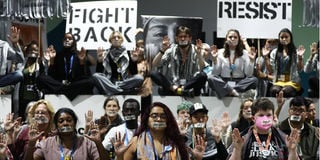Premium
COP29 failed Africa: Here’s what went wrong with climate financing bid

Activists hold a protest during the COP29 United Nations climate change conference, in Baku, Azerbaijan November 23, 2024.
What you need to know:
- The African bloc of government leaders went into COP29 with a finance demand of US$1.3 trillion per year.
- Developed and developing countries reluctantly agreed to set a new collective quantified goal on climate finance.
The United Nations’ 29th annual climate change conference of the parties, COP29, ended with countries from the global north committing US$300 billion per year in climate finance to developing countries.
This money is meant to pay for developing countries to carry out climate change adaptation and mitigation and move away from fossil fuels. But the amount falls far short of the US$1.3 trillion per year needed.
Kudakwashe Manjonjo of the Southern Centre for Inequality Studies at the University of the Witwatersrand and Power Shift Africa was at COP29 in November 2024. He unpacks what went wrong for Africa.
How much money were African countries aiming to secure?
The African bloc of government leaders went into COP29 with a finance demand of US$1.3 trillion per year to be provided to developing countries, including African countries, by developed nations from 2025.
African countries would have used their share of this climate finance to cope with climate change, loss and damage (compensation for damage caused by climate change) and mitigation (ways to work within the warming world).
The figure of US$1.3 trillion per year was based on research conducted by independent experts tasked by the COP26 and COP27 presidencies. The rest of the global south took it up during the negotiations as a reasonable figure for developing countries to meet the Paris Agreement requirements.
What was achieved?
Developed and developing countries reluctantly agreed to set a new collective quantified goal on climate finance of at least US$300 billion per year by 2035 for all developing countries. Developed countries took the lead to provide and mobilise climate finance from public and private, bilateral and multilateral finance institutions.
The agreement also stated that other more affluent global south countries such as China, Singapore and Brazil were encouraged to contribute to this new yearly target.
A second target was agreed, calling on all actors – ranging from governments to private bankers – to scale up all sources of public and private climate finance to at least US$1.3 trillion per year by 2035. The agreement also launched the Baku to Belém Roadmap to 1.3T. This is a process that aims to scale up climate finance to developing countries through grants and interest free loans.
What were the major problems for African countries at COP29?
The main issue is that the US$300 billion per year falls far short of what is required for Africa to begin to cope with climate change and extreme weather disasters. For example, if inflation were to average 5 per cent per year across the continent over the next 10 years, then by 2035 the US$300 billion per year would only amount to US$175 billion in today’s terms.
This is barely any more than the US$163 billion that African countries pay every year to service their debts to the global north (in other words, on interest alone).
Secondly, geopolitical tensions caused uncertainty. These tensions were triggered by the election of Donald Trump as US president, the rise of far-right leadership in Europe and Argentina, ongoing conflicts in the Middle East and Ukraine, and food and energy affordability issues triggered by high inflation globally.
These political and humanitarian crises meant the climate agenda fell down the list of priorities of most countries, especially in the global north.
Lastly, Azerbaijan as a fossil fuel country hosting COP29 was a conflict. Azerbaijan’s focus is on delaying the transition to renewable energy as long as possible. Its president describes oil and gas as a “gift from God”. The lack of energy transition plans from Azerbaijan and continued investment in fossil fuels meant there were countries that could have been better hosts of COP29.
What needs to happen next?
COP29 established the “road to Belém” initiative, so climate finance will continue to be discussed at COP30 in Belém, Brazil in November 2025. African countries need to negotiate better deals with countries on a state to state level and link those negotiations with multilateral negotiations such as COP30.
For example, the global north is seeking critical energy transition minerals in Africa through the Minerals Security Partnership. They are willing to invest billions for access to Africa’s minerals. But they are not willing to give African countries the climate change adaptation finance they ask for at COP meetings.
Therefore, Africa should withhold minerals such as copper, lithium and graphite that are necessary for the energy transition if finance for climate adaptation is not forthcoming. This way, the United Nations’ annual climate change meetings will stop being talk shops and become the action based discussions that are necessary to avert further climate disaster.
By Kudakwashe Manjonjo - PhD Candidate: Southern Centre for Inequality Studies, University of the Witwatersrand




